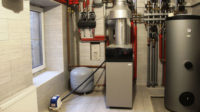A look at how radiators were rated
Number crunching.

Go look in a radiator catalog and you’ll see the equivalent direction radiation ratings for all those different shapes and sizes. We take those numbers for granted nowadays, but believe me, none of that came easy.
At the turn of the 20th century, the American Radiator Company was the big cheese when it came to hydronic heating. Most buildings around the world that had heating in those days had American radiators and Ideal boilers.
The company published a monthly magazine called the Ideal Heating Journal that usually featured a photo of a building on the cover with a proud caption that told how this building was heated with its boilers and radiators. We’re talking buildings such as the White House and the Vatican here. These were serious people.
And because of that, the budding hydronics industry looked to American Radiator Co. for leadership and research. The company built a facility in Buffalo, N.Y. (cold enough for you?) that it called the Institute of Thermal Research. And isn’t that a grand name? This is where they tested their radiators under real-world conditions and figured out (to a ridiculously accurate degree) how much heat those radiators will give off. Here’s how they did that:
On the north side of the building (to avoid direct sunlight), they built six rooms. The two on the corners of the building measured 15 ft. square and each had a different exposure to the elements. The four intermediate rooms between the corner rooms measured 10 ft. by 15 ft. In one of these rooms, they installed a chimney and a grate, as some people had in those days. They used the same windows that folks would have in their houses or apartments. They tried to make this as real-world as possible.
They drilled a number of holes in the floors for the radiator pipes and they covered the holes they weren’t using with iron cover plates. This made it easy for them to move a radiator around the room to see what sort of difference, if any, that made to the radiator’s output.
Below these rooms was the weighing room. This is where they would weigh the condensate that drained from a radiator they were testing. The weighing room also housed the steam boiler. This boiler maintained a pressure between 10 and 15 psi. They used a pressure-reducing valve to lower the pressure going to the radiators to 2 psig, or any other pressure they wanted to try.
Steam left the PRV and entered a receiver designed to remove water from the steam. From there, the steam went to a steam main that led to the radiators. They drained the receiver and the mains by hand, using petcocks. It was very important to deliver only dry steam to the radiators because any water carried over from the boiler would show up on the weighing-room scale as water coming from the radiator and that would result in a false rating for the radiator.
The same went for the condensate that came from the main as it heated. They didn’t want that to enter the radiator either, so they were careful to drain it all by hand. They really thought this through.
From the return of each radiator, they ran a small pipe though the floor and into the weighing room below. The condensate flowed by gravity through that pipe and entered a condensation pot. And that led to more questions. If they used an ordinary pot, the pot itself would have a heat loss and that would throw off their readings. There is no insulation that is powerful enough to avoid this, so instead of using a plain pot, they used a steam-jacketed pot, which worked beautifully.
To weigh the condensate, they used six pairs of specially constructed scales, one for each radiator under test. They placed the scales and the pots into where the condensate was to be drawn directly below the steam-jacketed pot. These scales were very accurate, capable of measuring to the hundredth of a pound.
Calculating time
In testing, they expressed the efficiency of a heating radiator by a coefficient of Btus given off per square foot of heating surface per degree difference between the steam (or water) inside the radiator and the air surrounding the radiator. For example, suppose they got these results from a test:
Heating surface of the radiator = 40 sq. ft.
Temperature of the steam = 218° F
Temperature of the air in the room = 70° F
Temperature difference between the radiator and the room = 148° F
Condensate produced per hr. = 9.86 lb.
To figure the coefficient, we take the condensation per sq.-ft. of heating surface per hour (9.86 lb.) and we divide that by 40 (the square footage of the radiator). That gives us 0.2465 lb. Since the latent heat of the steam at 218° F is 966.5 Btu, the number of Btu given off per square foot of radiator surface area is 0.2465 X 966.5, which is 238 Btu.
And since the temperature difference between the steam and the air in the room is 148° F, the heat emission per degree of difference (238 divided by 148) is 1.608 Btu. That number is the coefficient of the radiator. It shows the quantity of heat given off per square foot of surface per degree of difference between the temperature of the radiator and the temperature of the air surrounding it. They used that to figure the amount of heat given off from any radiator of similar design when they placed it in a similar location in the test room.
If the temperature difference between the radiator and the air in the room is 140, 160 or any other reasonable figure, a contractor could use the coefficient to come up with the radiator’s output, but if the conditions on the job vary widely from those in the test room, the radiator probably wouldn’t perform the same way.
That’s why the test rooms that the American Radiator Co. built were very similar to what you’d find in an ordinary house or apartment back in the day. They took no precautions against heat loss. They didn’t fit the windows any tighter than a carpenter of that era would have fitted them. They were going for practical rather than academic, and since we still see many of these radiators in service nearly a hundred years later, I’d say they did a very good job.
In the beginning, when manufacturers were first making all this stuff up, they measured the surface area of a radiator by dipping it into a large vat of paint, which they would first weigh. They’d let the excess paint drip off the radiator and back into the vat, and then weigh the vat again. Whatever was not in the vat was clinging to the surface of the radiator. They then took that much paint, by weight, and painted the floor. However many square feet of floor surface they could cover with that amount of paint became the declared square-foot surface of the radiator.
Lots of thought went into that one.
And isn’t this just the best business in the world?
HELPFUL LINKS:
Looking for a reprint of this article?
From high-res PDFs to custom plaques, order your copy today!






